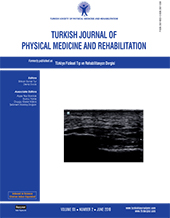Estimating the most accurate sonographic measurement in the diagnosis of carpal tunnel syndrome: Which is the best?
2 Department of Physical Medicine and Rehabilitation, Gaziler Physical Therapy and Rehabilitation Training and Research Hospital, Ankara, Turkey
3 Department of Physical Medicine and Rehabilitation, Girne University Faculty of Medicine, Girne, KKTC DOI : 10.5606/tftrd.2019.2421 Objectives: This study aims to identify the most accurate method or ultrasonographic measurement for the diagnosis of carpal tunnel syndrome (CTS).
Patients and methods: Between October 2010 and April 2011, a total of 160 hands of 87 patients (4 males, 83 females; mean age 54.5 years; range, 26 to 84 years) with clinically and electrodiagnostically proven CTS and 80 hands of 40 controls (3 males, 37 females; mean age 53.7 years; range, 32 to 77 years) were evaluated by sonographic examination. The diameters and cross-sectional areas (CSA) of the median nerve and longitudinal diameters of the median nerve were measured at the inlet, proximal carpal tunnel, and outlet of the carpal tunnel. Volar bulging and thickness of the retinaculum were also measured.
Results: The most optimal combination for the diagnosis of CTS was proximal CSA, volar bulging, and the proximal transverse diameter. The combination of proximal CSA with volar bulging increased the sensitivity and specificity of sonographic measurements.
Conclusion: Based on our study results, ultrasonography can be used as a practical modality to distinguish CTS patients from asymptomatic controls.
Keywords : Carpal tunnel syndrome, electrophysiology, median nerve, ultrasonography
















